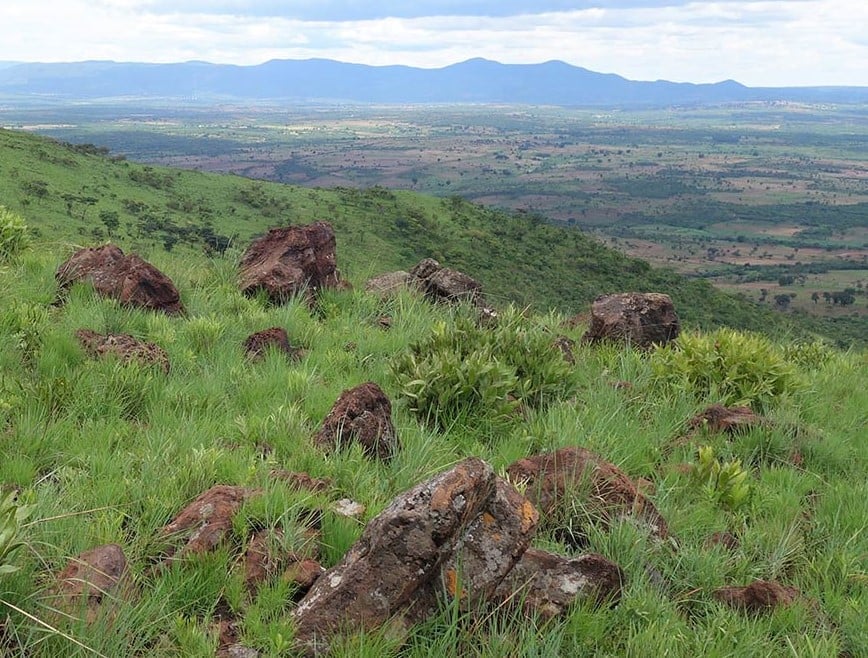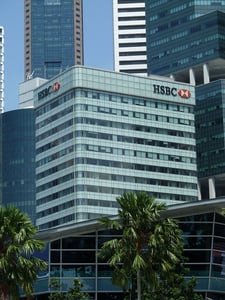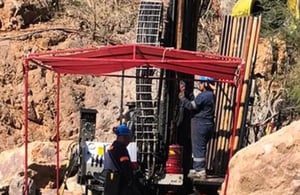Pensana plc (LON:PRE) has announced that, further to the announcement of 29 August 2023, which reported high grade TREO soil sampling results at Sulima West and encouraging results from other targets on the Coola exploration licence area, the company has now reported on the Mineralogical Characterisation studies undertaken by SGS South Africa of samples collected at Sulima West and the Coola carbonatite during 2022.
– Sulima West laterite mineralisation contains monazite which hosts NdPr with moderate liberation and exposure which should be amenable to some degree of simple upgrading at the current location, prior to processing at Longonjo;
– The Coola carbonatite contains a significant amount of bastnaesite which is host to more than 90% of the NdPr. The bastnaesite is moderately liberated and exposed, again suggesting that there is potential for recovery using the physical separation at the current location prior to processing at Longonjo.
Exploration Manager, Grant Hayward, commented:
“We are encouraged that the initial mineralogical study has confirmed the processing potential of the rare earth host minerals for both the Sulima West laterite and the Coola Carbonatite.
The opportunity for upgrading the ore at the current location using physical separation techniques will be further assessed with the testing of larger samples which are in the process of being collected.
We obviously see both Sulima West and Coola carbonatite as having the potential for upgrading the ore at its current location and thereby providing a high-grade near-term feedstock 40 kilometres from Longonjo.”
RESULTS
Sulima West Laterite target
– The Sulima West laterite contains three main types of rare earth minerals namely bastnaesite, monazite and florencite. The important NdPr mineralogy occurs mainly in the monazite, whilst the bastnaesite hosts the Cerium and the Lanthanum occurs in the florencite.
– The minerals have been partially liberated from the weathered host rock and should be amenable to some degree of simple upgrading at the current location, whilst the moderate exposure noted should be sufficient for successful process route leaching, with the bastnaesite and the monazite showing the highest recovery potential.
Sulima West Apatite Maghemite target
– The majority of the rare earth minerals present in the Apatite-Maghemite sample occur in the apatite. The apatite is relatively coarse-grained and is well liberated and exposed. Whilst apatite is not a typically recovered rare earth mineral this sample is well liberated and exposed and as such would be amenable to potential recovery and may constitute a significant phosphate resource.
Coola Carbonatite
– Coola Carbonatite contains a significant amount of bastnaesite which is host to more than 90% of the light rare earths (NdPr La Ce) found in this sample. As the bastnaesite is moderately liberated and exposed, there is potential for recovery using the physical separation at the current location prior to processing at Longonjo.
All targets occur within the Coola Exploration License (No059/02/01/T.P/ANG-MIREMPET/2020) located 40 kilometres north of Longonjo. A combination of Chemical Analysis (major/minor/trace and REE analysis), XRD, TIMA, and EMPA were applied to determine the bulk modal mineralogy of the sample and characterization of the REE-bearing mineralsand the report highlights included:
Mineralogical Analysis by SGS comprised:
- Three individual samples were received by SGS, each of the samples were crushed to 100% passing 1mm and subjected to a rotary splitter to obtain a representative sub-sample. The remainder of unpulverized aliquot was pulverised and homogenised for X-ray Diffraction analysis (XRD) and analysed for major element oxides, trace elements and for rare earth elements. The remainder of unpulverized aliquot from the rotatory splitter was prepared into polished sections for Automated scanning electron microscopy analysis (AutoSem) using Tescan Integrated Mineral Analyzer (TIMA).
- Electron microprobe EMPA work was required in order to determine the mineral chemistry of the REE-bearing minerals, particularly the element present at low concentration, which was required for the REE deportment and was incorporated into the TIMA data.
- Each sample was studied for bulk modal mineralogy, REE deportment, grain size distribution, mineral association, mineral liberation and exposure.
About the Coola Exploration Project
The Coola Exploration Project located in Angola, approximately 160 km east of Port of Lobito covers an area of 7,456 square kilometres. The Coola Exploration Project consists of three highly prospective targets namely the Sulima West carbonatite, the Benga Novo alkaline complex and the Coola carbonatite. The three highly prospective targets are located between 40 and 100 kilometres north of Pensana’s Longonjo project.
Pensana, through Coola Mining LDA in which Pensana holds a ninety percent interest, was granted the Coola exploration license in May 2020 and has since completed multiple field programmes in 2020, 2021 and 2022 involving geological mapping, rock chip sampling, trench and pit sampling, stream sediment sampling, initial radiometric surveys, close space soil sampling and assaying confirming rare earth mineralisation across all three carbonatites/alkaline complexes.
The Coola carbonatite is a roughly circular body, measuring about 900 metres across as inferred from the limited outcrops of carbonatite and fenite. The circular shape suggests that the Coola carbonatite may be a ring dyke or breccia pipe, similar to the carbonatite at Longonjo. Rock chip sampling of the 0.9 km diameter Coola carbonatite ring dyke returned values of between 0.6% and 4.9% TREO (average 2.6%). Soil geochemistry over the covered carbonatite returned values of between 0.37% and 13.18% TREO (average 3.21%).
Mineralogical studies of the Coola carbonatite identified the rare earth mineral to be bastnäsite, which occurs as discrete veins, veinlets, and segregations within the carbonatite. Soil geochemistry over the fluorite-rich zone at Coola identified an area of 13 000 m2 with average fluorite values of 17% (Calcium Fluoride) CaF2. Economic grades of REE mineralisation in the form of bastnaesite has been located in banded dolomitic carbonatites at the Coola carbonatite. In Q3 2023, ground radiometric surveys (magnetic and radiometric) were completed over the Coola carbonatite and data is currently being processed and interpreted.
Sulima West is a 4.2-kilometre diameter alkaline carbonatite ring complex with a corresponding high radiometric
response occurring immediately to the south of the Benga Novo intrusion and to the west of the Sulima ring structure. Ten historic trenches each of about 90 metres in length located in the western segment of the structure were identified and corresponded with the highest radiometric response.
Twenty-two initial reconnaissance samples were extracted from the trenches in 2021. During this sampling, it was observed that the trenches were excavated into an iron/manganese-rich laterite very similar in appearance to the rare earth element laterite developed over the Longonjo carbonatite.
Results of this initial sampling returned significant values for rare earth oxides with up to 10.6% TREO encountered in the laterite and averaging 4.2% TREO. Manganese oxide values of up 15.9% MnO and averaging 7.2% MnO were also reported.
In Q2 2022, further trench and pit exploration activities were conducted at the Sulima West target, reporting initial rare earth grades of up to 9.7% TREO averaging 3.4% TREO over 68 metres at surface in the trench and up to 5.2% TREO, averaging 4.3% TREO over 6 metres at surface for the pit. During 2022, two hundred and thirty-eight soil samples were collected on a 50 m x 50 m sample spacing over an area of 650 m x 800 m covering the area of identified historic trenches and surroundings at the Sulima West target.
Individual soil samples are from 10-20 cm below surface, were sieved to <0.5 mm, bagged and dispatched for ICP-MS analysis at IGEO Laboratories, Luanda.
The soil sampling clearly identifies an area of approximately 500 m x 300 m (~15 hectares) with >2% TREO in soils within which a zone with >3% TREO is delineated. In Q3 2023, ground radiometric surveys (magnetic, radiometric and gravity) were completed over the Sulima West target and data is currently being processed and interpreted.
The presence of highly anomalous TREO of >10%, the anomalous radioactivity, outcropping fenite, as well as significant manganese and supergene apatite, are all supportive of a carbonatite at depth.
The Benga Novo intrusion is interpreted as a very large caldera occurring immediately to the north of the Sulima West intrusion. It is regarded to be at least 8 to 10 kilometres across and is characterised by flat, deeply weathered soils with a solitary alkaline granite outcropping in the south eastern part.
The identification of a significant, clay dominated, deeply weathered regolith over parts of the main Benga Novo intrusion may additionally be prospective for the occurrence of ionic clay hosted REE deposits and possible bauxite.
Whole rock geochemistry and analytical results of clays collected from the deeply weathered Benge Novo alkaline complex showed a low Al2O3 content (<18%) with no bauxite minerals identified, however, the clays typically contain up to 1600 ppm TREO. The REE distribution shows a typical LREE distribution. XRF reports 65% SiO2, 18% Al2O3, 4.4% K2O and 3.5% Fe2O3. XRD work reported 46% quartz, 23% microcline, 26% kaolinite and 5% phlogopite for these clays.
The Benge Novo complex is vast (10 km minimum in diameter) and largely soil covered. Further mapping, sampling and possible geophysics is required to effectively assess and explore this prospective alkaline complex.
About Angola
The Angolan government has implemented a modern mining code with an attractive fiscal regime and a range of investment incentives including tax exemptions and customs duty exemptions. Over the past decade it has also made significant investments in business-critical infrastructure such as railways, ports, bridges, and roads.
The Lobito Corridor railway, the historic 1739 km umbilical cord to the strategic minerals mined in the Copperbelt straddling the DRC and Zambia, is now under concession management by the Trafigura/Mota-Engil led Lobito Atlantic Corridor consortium. Alongside the management of Lobito Port, it is the latest under the roll-out of government privatisation initiatives. Angola currently enjoys a power supply surplus following mega hydro-electric projects and expansion of the national grid.
Angola’s economic profile has improved significantly over recent years, with the country’s public debt falling from 131% of gross domestic product in 2020 to 66% in 2022. The IMF has projected that the economy will grow by 3.5% in 2023.
Following an upgrade by Moody’s in late 2021, all three major rating agencies raised their credit assessment of the country’s sovereign debt in 2022, with Fitch and Moody’s upgrading the country outlook from neutral to stable in the second half of the year.







































